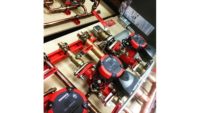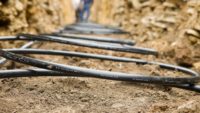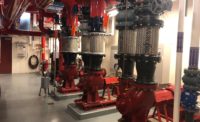Geothermal energy has been making big headlines recently — from Google announcing it plans to operate its entire business on carbon-free energy by 2030 and will turn to next generation geothermal energy to power data centers and infrastructure in Nevada to oil giants BP and Chevron partnering with geothermal start-ups to New York Mayor Bill de Blasio announcing the city will take critical steps to advance the implementation and integration of district geothermal systems. The consensus is clear that geothermal offers a path toward clean energy goals.
“Renewable energy is, and should be, a core focus for us all,” notes Adam Koontz, senior sales engineer for domestic buildings OEM for Grundfos. “Energy consumption is a major concern in commercial environments and many commercial buildings have systems that are more than 25 years old. Owners are more open to renewables now than ever before. All buildings are looking to reduce their carbon footprint. Renewables used to be the ‘upsell,’ but now, we are seeing owners reaching out to us with interest in renewables, such as geothermal.”
According to Will Lange, director of utility marketing, WaterFurnace International, new technology and electrification project funding are coming online.
“Investor owned utilities, for example, are matching up project funding with access to new heat sources such as surface water, storm water and even building foundations,” he says. “Commercial geothermal is also proving an ideal solution for projects minimizing refrigerant usage by distributing heat with water.”
“Electrification and decarbonization are the primary growth drivers in our space,” adds Tim Hammond, senior director of commercial engineering, WaterFurnace International. “With increased adoption of renewable energy technologies and a positive political climate, WaterFurnace continues to invest in the commercial chiller, water-source heat pump and the geothermal heat pump space.”
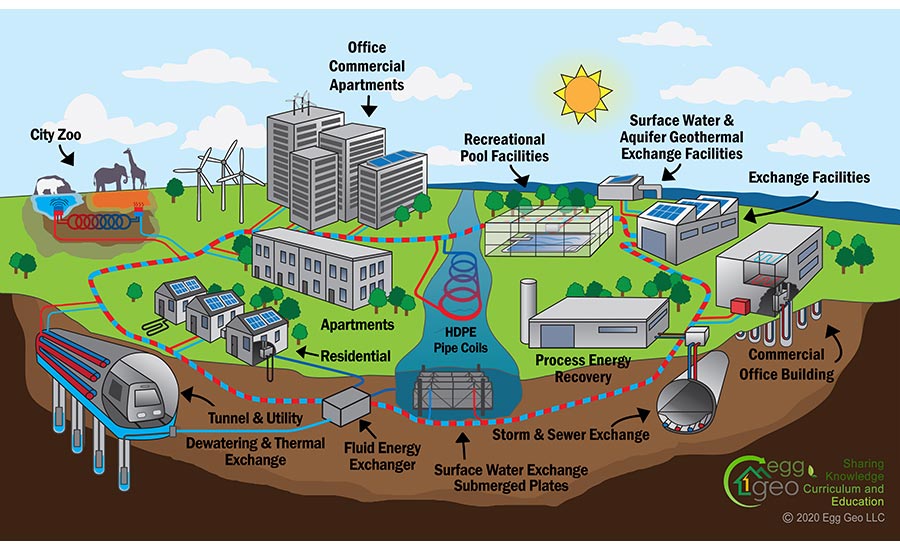
Geothermal energy networks are not just a passing craze, according to Jay Egg, president of Egg Geothermal. The engineering, consulting and installation firm has been involved in many of these types of projects all across the country, and keeps hearing about more all the time. Photo courtesy of Egg Geothermal
Goncalo Costa, director of AC Regional Business Unit, North America for Bosch Thermotechnology, says the light commercial geothermal market is growing, largely based on sustainable residential and district geothermal developments. While the large commercial market is suffering due to the COVID-19 pandemic, he believes it will bounce back as the economy recovers in the second half of the year and into 2022.
“Incentives are still a significant driver for both commercial and residential geothermal segments, but we also see a much stronger awareness for electrification and sustainability behind the decision making process,” he explains. “As the larger commercial projects recover post-pandemic, the federal tax incentives will positively impact the recovery of the commercial segment.”
Doug Dougherty, president and CEO of the Geothermal Exchange Organization (GEO), is very optimistic that the industry will see an increase in the investment tax credit as part of the new infrastructure bill, which lists clean energy technologies such as solar, combined heat and power and others — which are treated with a 30% investment tax credit while geothermal still only sees a 10% credit.
“We’ve pleaded our case to the House of Representatives and to the Senate to give us parity in that section of the code, and we’ve got an agreement from both that it’s going to be fixed,” he says. “So two things will happen in the commercial space. One, commercial building owners renovating their buildings or building new construction will be able to secure third-party financing for the geothermal heat pump system because we’ve seen that before in other cases where they will lease the HVAC system to the building owner. That way, the building owner doesn’t have any capital outlay for that geothermal heat pump system. Then, the other benefit to having parity with the investment tax credit of 30% is there will be more geothermal communities, such as Whisper Valley in Austin, Texas — it’s all solar and geothermal.”
Whisper Valley has a common loop that runs through the whole development and is owned by the developer.
“We think this will really jumpstart what I've been called ‘monetizing the ground heat exchanger,’” he says. “The developer owns the loops and lease them to the homeowners. It’s a built in revenue stream that lasts forever. These tax credits are really going to spur these types of sustainable communities in the future. It’s pretty exciting from our standpoint. Utility companies do essentially the same thing with solar. We hope to have that same sort of scenario play out with the ground loop heat exchanger, where the owner doesn’t have to pay for the loop — which can be as much as 30% to 40% of the total system cost. If you take that out of the upfront costs, our equipment is pretty much on par with a high-efficiency air conditioning unit or air-source heat pump in a fossil fuel backup. There are a lot of good things on the horizon.”
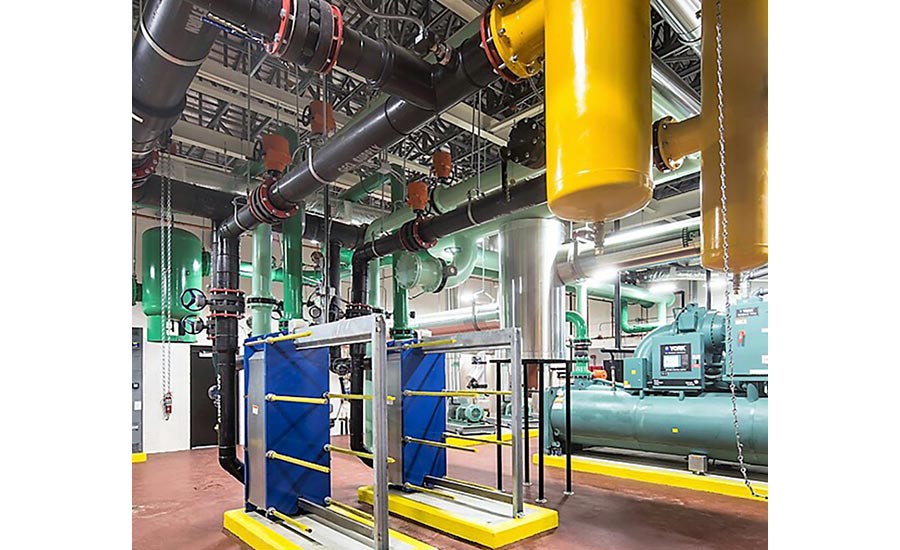

A geothermal central energy plant replaces a public school's boiler and chiller system.
The rise of geothermal energy networks
Jay Egg, president of Egg Geothermal, a geothermal consultancy, engineering and installation firm located in St. Petersburg, Florida, says the commercial market is growing dramatically.
“Much of the growth is in the Northeast, meaning New York and Massachusetts,” he says. “And the focus has gone from just doing big individual buildings to what is called geothermal energy networks, where a large geothermal pipeline is piped throughout a city block, or a neighborhood or a mixed use community, and then it becomes a utility that the buildings on that utility can tap into.”
Egg notes the rise of these energy networks is not just a passing craze, noting natural gas utilities in Massachusetts have applied to become geothermal utilities with the Public Service Commission and are doing pilot projects which will eventually replace natural gas pipelines with geothermal fluid or water pipelines.
“In New York, the New York State Energy Research and Development Authority (NYSERDA) has issued a public opportunity notice for anybody to bid on ideas and projects to implement geothermal energy networks in New York, and NYSERDA would either fund half or all of them, depending on different stipulations,” he adds.
These geothermal energy network projects are happening all across the country, many of them in universities and cooperative campuses, Egg notes. His company has been involved in many of projects providing engineering work and feasibility studies.
“I know firsthand how much is being invested in doing large commercial expansions,” he explains. “They're really taking hold — not just as I said in the Northeast, but throughout the country. We have another project in Reno that is moving forward that involves 4,000 acres of mixed use land, and more projects are being planned. There are more Whisper Valleys popping up in more places than I know about. I hear about more every week.”
As for what is driving the push toward geothermal energy networks, Egg points to the widespread power outage that left millions of Texans with no power or heat during an unprecedented winter storm that struck the state in February.
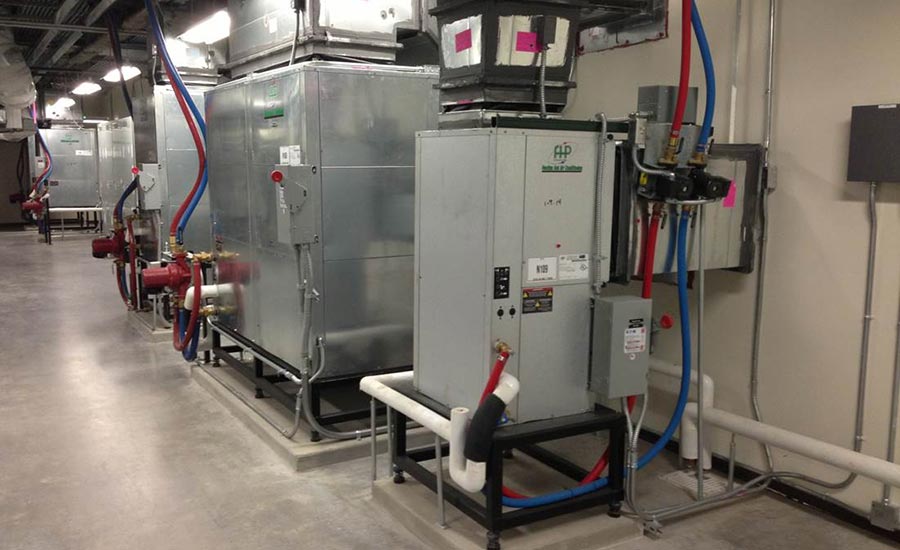
Another advantage of geothermal systems is all the equipment is indoors, so it is never exposed to the elements. All photos courtesy of Egg Geothermal
“The Texas grid problem was a result of too many people trying to heat at the same time — they peaked out the electric grid and crashed it for a while,” he says. “So if you think about that, the strategic reason for geothermal systems to be implemented is to reduce electrical infrastructure over the next 20 to 30 years as these communities — especially gas or combustion heating communities — cities and states move from gas to all electric heating. If they don't do it carefully, they'll end up with what happened in Texas. If they all go off the fossil fuel heating, and switch to electric heating irresponsibly, they will crash their grid.
“The summer is the peak in most areas, and certainly in the Northeast because air conditioning, which is electric, hits the peak on the hottest days of the year,” Egg continues. “The winter peak can be twice that of the summer peak, if not more, because of heat pumps. They operate great at 0° F, but once it gets below zero, they’re going to go into defrost. The DOE itself says air-source heat pumps are great, except when it gets too cold because they defrost so much, it really just brings the COP down to basically nothing.”
Egg explains NYSERDA is investing triple digit billions of dollars into geothermal infrastructure with the goal of getting at least 40% of the market on geothermal heat pumps.
“The other 60% can be on air-source heat pumps,” he says. “If they have a base load of geothermal, they can control that winter peak and keep it at or below the summer peak. What that does is it makes it so the existing grid will operate as it always has because the winter peak will be no worse than the summer peak. They ended up saving trillions of dollars in grid infrastructure upgrades, and by investing billions of dollars now into infrastructure, that will help control the growth. Basically, it's a thermal energy network, which is another way of moving energy around and helps control electrical costs. And it's been proven over and over again in studies, if they spend $1 on geothermal infrastructure, they'll save $3 in grid infrastructure over the next three decades.”
Koontz adds he expects these types of geothermal projects will play a big part in the future.
“We’ve already seen successful installations of district heating,” he says. “Larger systems are simply more efficient, even when you factor in the energy required for distribution. Frankly, as a country, we should have started this a long time ago.”
WaterFurnace has participated in a variety of commercial distributed resource projects for decades, Lange notes.
“A recent landmark pilot project in Riverhead, New York, at Glenwood Village proved out the concept of load sharing and diversity in a district geothermal project,” Lange says. “Every new large project increases feasibility and demonstrates repeatable results in applied efficiency and reliability. From the Lockport Housing Authority (New York) modest income housing project to another recent success at Beach Green Dunes in New York City, it becomes progressively more clear that geothermal delivers great results in urban, high density situations as well as an Indiana farmhouse.”
Additionally, with the trend toward electrification in urban areas, utilities will be able to secure a better business case with geothermal when compared to an investment in traditional gas infrastructure, Costa adds. “The technology certainly already exists to enable these applications.”
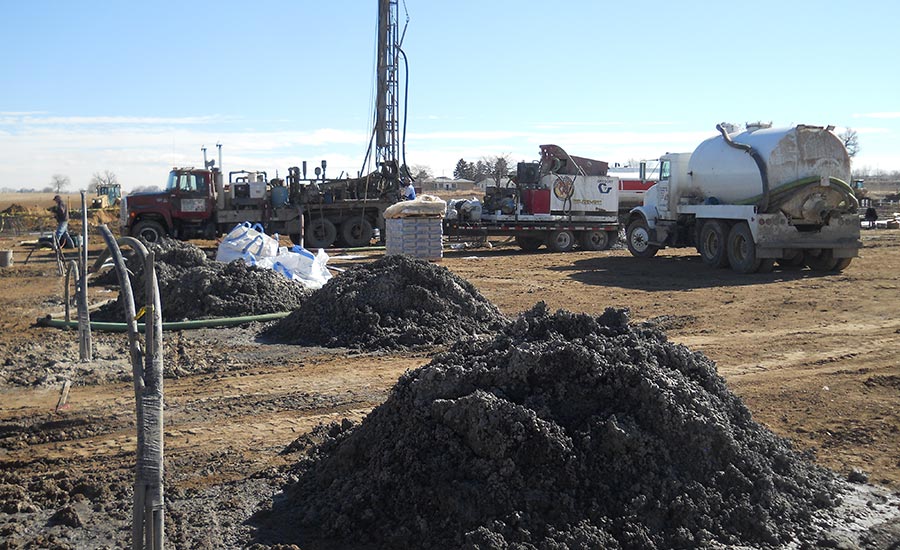
Goncalo Costa, director of AC Regional Business Unit, North America for Bosch Thermotechnology, notes utilities will be able to secure a better business case with geothermal systems with the trend toward electrification in urban areas. Photo courtesy of Bosch Thermotechnology
Meeting climate goals
Dougherty wholeheartedly believes geothermal energy is the answer to meet clean energy and low emissions goals.
“If we’re going to attempt to decarbonize buildings, we ought to go to the power plant of the building, which is how you heat and cool your home or your building,” he says. “And the most efficient way, bar none, has been touted by the EPA, DOE, ASHRAE and more, is with a geothermal heat pump. There's no other technology that can beat us. If you let the market operate as a free market with no governmental intervention using the tax code, we win.”
Egg agrees, saying, “Geothermal heat pumps and geothermal systems — when I say geothermal, I should say geothermal exchange because a lot of our work involves coupling central energy plants, chiller plants and heat recovery chillers for hospitals and campuses to a geothermal exchange loop — are the key because they eliminate the need for combustion heating on site while maintaining a high COP. Air-source heat pumps are great for certain applications, especially south of the Mason-Dixon Line, where they operate efficiently in the winter even in the coldest days, typically. But heat pumps in general are the key to eliminating combustion heating and decarbonizing our country.”
Lange notes that, in many cases, geothermal is the only economically viable option.
“As Eversource Energy made clear in their Massachusetts Rate Case Filings after the Merrimack Valley/Colombia Gas incident, providing ground temperature water to distributed heat pumps with COPs over 4.0 is the only realistic alternative to digging up 100 year old gas pipelines,” he explains.
“Also, fossil fuel sunset laws in some areas will leave 80 year gas pipeline depreciation schedules high and dry. But simply moving gas customers to straight electric heat, or even ‘cold climate heat pumps’ is only an 80% solution, as we saw in February in Texas: Geothermal heat pumps are needed to deliver the necessary heat with ultra-high efficiency in ultra-low temperatures.”
“There is no silver bullet to reach this goals but district geothermal systems are well positioned to be a key component of the mix because it enables the highest levels of efficiency amongst HVAC technologies,” Costa adds.
While geothermal itself will play a part toward energy efficiency goals, Koontz says the real answer will be how district-style systems will change up the business model.
“Users will now be paying for Btu consumption directly, and it will be up to the ‘utility’ company to maintain the loop,” he notes. “District systems also help to unburden end-users of the large upfront borefield costs. Overall, this should help promote renewable energy technologies and educate end-users on energy efficiency.”
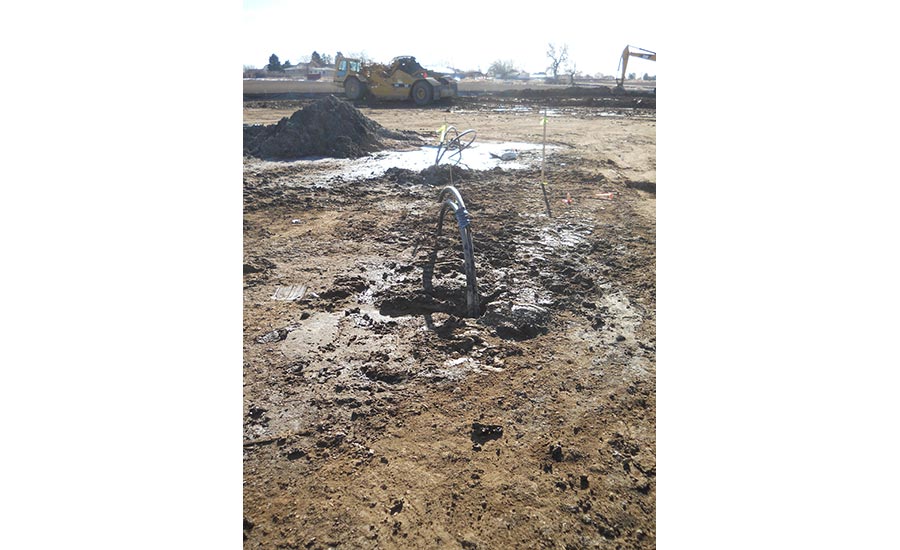
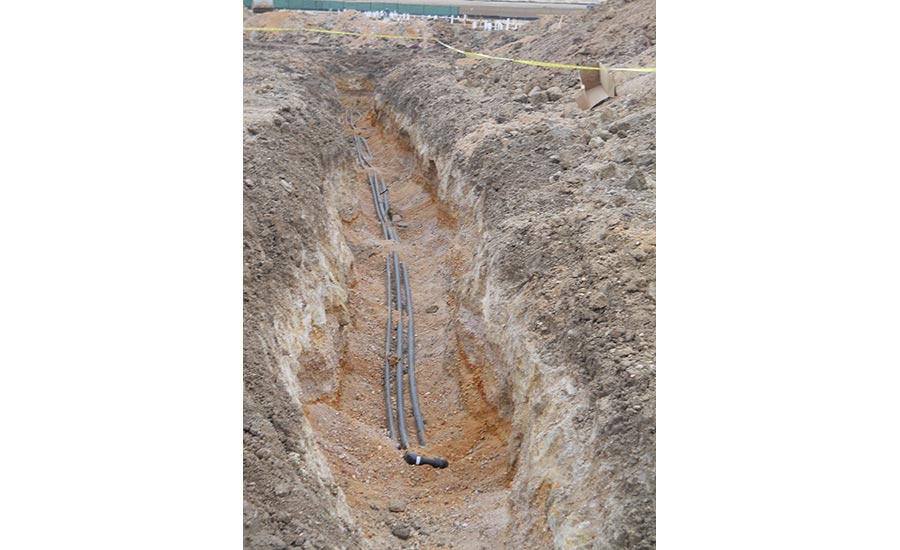 Shared geothermal ground loops would allow builders or utilities an endless built-in revenue stream as they lease it to homeowners or building owners. Photo courtesy of Bosch Thermotechnology
Shared geothermal ground loops would allow builders or utilities an endless built-in revenue stream as they lease it to homeowners or building owners. Photo courtesy of Bosch Thermotechnology
Looking ahead
As long as the geothermal industry can get tax certainty, Dougherty says the future is very bright.
“I’ve been in this industry for 30 years and I’ve never been more optimistic than I am now,” he says. “But I will give you a modicum of concern. From a manufacturing standpoint, we’re in a good spot where we could increase the capacity from the manufacturing of the actual heat pumps. But my bigger concern is downstream with distributors, dealers and qualified installers. IGSHPA is preparing for an uptick in the growth of the market and qualified labor is a big deal. We recognize that, and we realized it could be a potential barrier to our staying on top of our growth. We need a workforce.”
Egg sees the market heading toward a change in workforce development.
“We know we have a construction labor shortage right now, and indeed, that’s very much the same thing in the HVAC world,” he says. “We as a country are in the process of providing workforce development for the change from combustion heating, such as boilers and furnaces, to electric heating, which is fundamentally heat pumps. It’s a big workforce development effort.
“The country — and the world — is moving to beneficial electrification or decarbonization mode over the next 20 to 30 years,” Egg continues. “The best educational money or workforce development money would be spent on making sure our HVAC installers, our engineers, even our architects, are trained on how heat pumps can provide all electric heating and cooling, specifically the application of geothermal heat pumps.”
Though predicting the future is tricky, Lange notes, “All indicators point toward a district geothermal wave leading to standard practices by the next decade. While beneficial electrification demands geothermal heat pumps, local carbon emission restrictions, fossil fuel distribution and climate resiliency needs all point toward large scale deployments of commercial geothermal districts. When stacking up the various heating alternatives, circulating ground temperature water around cities to operate 400% efficient heat pumps looks pretty attractive to most folks.”
According to Costa, there is a trend toward variable speed geothermal equipment, which enables enhanced comfort and efficiency at very low sound levels. “We also see a trend towards connectivity and mobile applications, which can display the benefits of geothermal systems to end users, and support technicians in installation and maintenance of the equipment.”
Koontz has two words for the industry: “Buckle-up.”
“Geothermal pairs quite nicely with photovoltaic (PV) systems, so it will be an integral component of the ‘zero carbon footprint’ movement for commercial buildings,” he says. “Geothermal is here to stay, and Grundfos is excited to see how it all plays out. We’re ready to play our part.”


